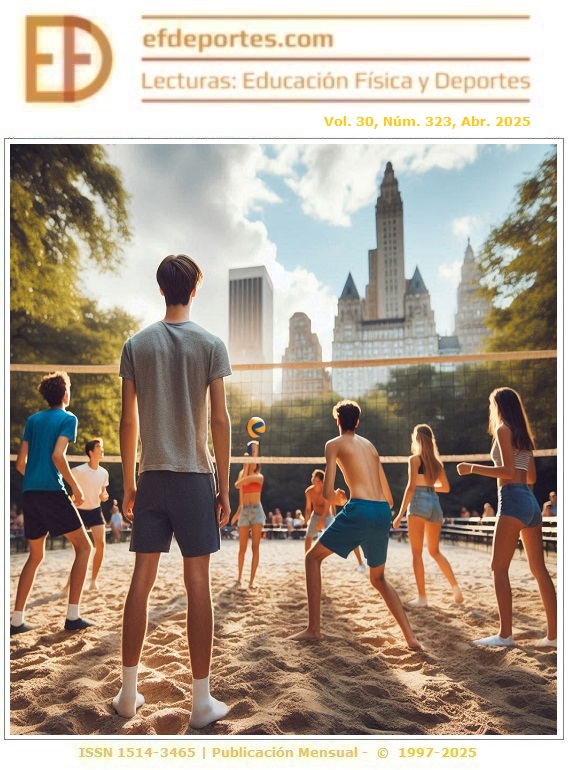Comparison of Flexibility and Joint Mobility in Student Dancers and Non-Dancers
Abstract
Flexibility and joint mobility play crucial roles in the health and physical performance of adolescents. With the growing interest in dance as a form of exercise and extracurricular activity, this study aims to compare flexibility and health-related joint mobility between adolescent dance practitioners and non-practitioners. The sample was intentionally selected and consisted of 20 female adolescents, aged 15 years, divided into two groups: Control (GC), with 10 non-dancers, and Dance (GD), with 10 dancers who had practiced for at least one year. Flexibility of the hamstring muscles was assessed using the sit-and-reach test, and hip joint mobility was measured by goniometry. Statistical analysis included Shapiro-Wilk tests (normality) and Student’s t-test for independent samples. The results showed that the dance group exhibited greater flexibility (GC=40.9 cm; GD=52.4 cm, p=0.001) and better results in several joint mobility tests: internal rotation of the right hip (GC=49; GD=51, p=0.002), flexion of the right hip with the knee flexed (GC=59.4; GD=62.2, p=0.007), and abduction of the left hip (GC=63.6; GD=68.8, p=0.001). It is concluded that dance practice is associated with greater flexibility and better joint mobility of the lower limbs in adolescents, promoting greater physical health benefits.
References
Alricsson, M., Harms-Ringdahl, K., Eriksson, K., e Werner, S. (2003). The effect of dance training on joint mobility, muscle flexibility, speed and agility in young cross-country skiers – a prospective controlled intervention study. Scandinavian Journal of Medicine and Science in Sports. 13(4), 237-243. https://doi.org/10.1034/j.1600-0838.2003.00309.x
Bazán, N.E., Bruzzese, M.F., Laiño, F.A., Ghioldi, M., e Santa María, C. (2016). Evaluación de la capacidad de salto y estado ponderal en estudiantes de danza clásica de la escuela del Teatro Colón en Buenos Aires. Apunts. Medicina de l'Esport, 21(190), 56-62. https://doi.org/10.1016/j.apunts.2015.07.001
Bennel, K.L., Khan, K.M., Matthews, B.L., e Singleton, C. (2001). Changes in hip and ankle range of motion and hip muscle strength in 8-11 year old novice female ballet dancers and controls: a 12 month follow up study. British Journal of Sports Medicine, 35(1), 54-59. https://doi.org/10.1136/bjsm.35.1.54
Cáceres Broqué, Y.Y., Madrigal Castro, A.D., e León Vázquez, L.L. (2018). La expresión corporal como alternativa del Deporte para Todos. Selección de ejercicios. Lecturas: Educación Física y Deportes, 23(239), 77-86. https://efdeportes.com/efdeportes/index.php/EFDeportes/article/view/418
Capricho, K.J.G, e Cancio, B.L. (2024). High School Students Flexibility Training in Dance. Internacional Journal of Resarch Publication, 148(1), 30-36. https://doi.org/10.47119/IJRP1001481520246371
Cigarro, N.M. dos S., Ferreira, R.E., e Mello, D.B. de (2006). Avaliação da flexibilidade da articulação do quadril em bailarinas clássicas antes e após um programa específico de treinamento. Revista Educação Física, 75(133). https://revistadeeducacaofisica.emnuvens.com.br/revista/article/view/370
Gaya, A., Lemos, A., Gaya, A.R., Teixeira, D., Pinheiro, E., e Moreira, R.B. (2021). Projeto Esporte Brasil PROESP-Br. Manual de testes e avaliação, 1-20. https://www.researchgate.net/publication/283529197
Guimaraes, A.S. (2024). A importância da flexibilidade no desenvolvimento motor de crianças dos anos iniciais nas aulas de educação física escolar. Revista Fisio & Terapia, 28(132). https://doi.org/10.5281/zenodo.10790957
Kaushik, P., & Kaushik, V. (2024). Evaluating the Impact of Aerobic Dance on Flexibility and Agility in Children with Intellectual Disabilities. International Journal of Social Sciences Arts and Humanities, 11(3), 90-93. http://dx.doi.org/10.13140/RG.2.2.21466.56006
Lee, K.Y.T., Hui-Chan, C.W.Y., e Tsang, W.W.N. (2014). The effects of practicing sitting Tai Chi on balance control and eye-hand coordination in the older adults: a randomized controlled trial. Disability and Rehabilitation, 37(9), 790-794. https://doi.org/10.3109/09638288.2014.942003
Liang, F., Hongfeng, H., e Ying, Z. (2024). The effects of eccentric training on hamstring flexibility and strength in young dance students. Scientific Reports, 14(3692). https://doi.org/10.1038/s41598-024-53987-0
Marques, A.P. (2014). Manual de goniometria (3ª ed.). Editora Manole.
Názario, V.F., e Silva, C.B. (2019). Nível de flexibilidade de alunos adolescentes praticantes de educação física e dança [Trabalho de conclusão de curso de graduação em Educação Física. Universidade do Sul de Santa Catarina – UNISUL]. https://repositorio.animaeducacao.com.br/handle/ANIMA/12567
Pérez, A.V., e Romero-Arenas, S. (2023). Estudio comparativo del perfil fuerza-velocidad con diferentes posiciones de partida del salto vertical en danza. Cultura, Ciencia y Deporte, 18(56). https://doi.org/10.12800/ccd.v18i56.1811
Rijaly, R., e Nurharini, A. (2023). Dance Preparation: Kinesthetic Exercise to Improve Jaranan Dancing Ability Extracurricular in Elementary School. Mimbar PGSD Undiksha, 11(3), 355-364. https://doi.org/10.23887/jjpgsd.v11i3.67477
Santonja-Medina, F., Gómez-Lozano, S., Baena-Chicón, I., e Vargas-Macías, A. (2020). Movilidad sagital espinal en bailarinas de danza Clássica. Revista del Centro de Investigación Flamenco Telethusa, 13(15), 10-19. https://doi.org/10.23754/telethusa.131506.2020
Author Biography
http://lattes.cnpq.br/1125012795747355
Copyright (c) 2025 Lecturas: Educación Física y Deportes

This work is licensed under a Creative Commons Attribution-NonCommercial-NoDerivatives 4.0 International License.









